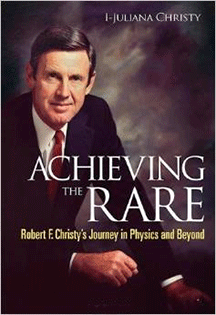By Jay Pasachoff
When I came to Caltech as a postdoc in 1970, I was proud and impressed to be among giants of physics—Richard Feynman, Willy Fowler, and Bob Christy among them. I also met top-level postdocs across the Institute, including Juliana Sackmann. Sackmann eventually married Christy, who died in 2012 in his 90s. She, having adopted first Sackmann-Christy and now Christy as a last name to honor him, has written this remarkable memoir, linking important American history, scientific history, and personal history.
The most significant section scientifically is about Christy’s work on atomic fission, starting in his graduate years with J. Robert Oppenheimer and continuing through his work on the Chicago Pile-1 in a squash court under the vacated stadium at the University of Chicago (which had, fortunately, abolished football), and on to designing the first atomic bomb at Los Alamos. Christy was at Los Alamos during 1943-1945, and the implosion bomb became known as the “Christy Gadget.” (If you want to know why it was called the “Christy Gadget” instead of the “Christy bomb,” this is the book for you.) A well-chosen variety of black-and-white photographs bring us a feeling of authenticity and a link to the times [which have recently been the subject of a 10-part TV serial about life at Los Alamos called Manh(a)ttan, though with largely fictional characters]. See also my review of The Most Controversial Decision: Truman, the Atomic Bomb, and the Defeat of Japan by Wilson D. Miscamble in The Key Reporter for fall 2011.
The book describes Christy’s interactions with most of the famous names of mid-century physics. Eugene Wigner, Enrico Fermi, Niels Bohr, and Hans Bethe are among them. After Los Alamos, Christy became Oppenheimer’s successor at Caltech. Following years of cosmic-ray science and other investigations, Christy sacrificed his science to become Provost and even Acting President at Caltech.
In reading the book, I came upon a personal link, in that I recall being inspired at Junior High School 22 in the Bronx in the 1950s to become a scientist when I heard about the carbon cycle and that it powered the Sun. I have since learned that, in fact, the carbon cycle (carbon-nitrogen-oxygen, or CNO) is important only in hotter stars, and plays a negligible role in fusion at the temperature at the Sun’s core, which is hot enough only to power the proton-proton chain. From this book, I learn that it was Christy’s doing to demote the carbon cycle from importance in our solar system. As of 2014, we even have direct detection of neutrinos from the main branch of the proton-proton chain, instead of from the subsidiary branches from which John Bahcall calculated theoretical rates, leading to the Nobel Prize in Physics to Ray Davis and Masatoshi Koshiba for their detection of the neutrinos, though at a reduced rate that led to the realization of neutrino oscillation, the astrophysics beating out the stodgy physicists who claimed that they understood neutrinos better than astronomers understood the temperature of the solar core.
Admirably, after his atomic-bomb experiences, Christy returned to science, taking up astrophysics. His explanations of variable stars, using his Los Alamos theoretical experience, even led to the Eddington Medal. Much later, he also used his experience from Los Alamos to deal with calculating more accurate historical radiation exposures of the populations of Hiroshima and Nagasaki.
Those interested in academic administration in general or Caltech in particular find still additional fascinating sections, but the scientific and practical history of the atomic age stand alone in this worthwhile book, with both science and personal history well told.
Astronomer and author Jay Pasachoff is the director of Hopkins Observatory and Field Memorial Professor of Astronomy at Williams College.




